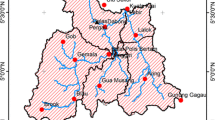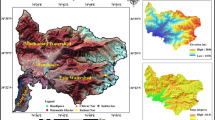Abstract
Lag time (tL) and time of concentration (Tc) are essential time parameters used in hydrological flood-flow design methods for estimating peak discharge and flood hydrograph shape. They form the basis of a number of hydrological models used among the scientists. Kelantan River basin, Malaysia, is a tropical catchment receiving heavy monsoon rainfall coupled with intense land use/land cover (LULC) changes making the area consistently flood prone thereby deteriorating water balance in the area. The most recent is that of December 2014 flood which lead to catastrophic loss of huge amount of properties worth millions of Malaysian ringgit. In view of this, the current research was conducted with the aim of develo** (1) tL and Tc based on 1984, 2002, and 2013 LULC conditions; (2) a relationship between tL and tL parameters; and (3) a relationship between tL and Tc among different LULC conditions. Kelantan River basin was first delineated into four major catchments, viz., Galas, Pergau, Lebir, and Nenggiri, due to its large size (approximately 13,100 km2). Soil map and LULC change maps corresponding to 1984, 2002, and 2013 were used for the calculation of CN values while NRCS lag equation was used for the estimation of tL and Tc. The results showed that deforestation for logging activities and agricultural practices were the dominant LULC changes across the watershed. Low values of both tL and Tc were obtained across the catchment which are typical for a tropical monsoon catchment characterized with high runoff and short peak discharge. Results of tL and Tc in this study are not affected by LULC changes in the basin. Slope was observed to be highly correlated with tL. Correlation coefficient was used to determine the relationship between tL and tL factor, and hydraulic length and slope (L√S). The results showed high correlation in all the catchments from 1984 to 2013 except for Lebir catchment where a moderate correlation was observed. The findings of this study may be useful to water resource planners in controlling water loss for future planning.








Similar content being viewed by others
References
Abdulkareem JH, Pradhan B, Sulaiman WNA, Jamil NR (2017) Prediction of spatial soil loss impacted by long-term land-use/land-cover change in a tropical watershed. Geosci Frontiers. https://doi.org/10.1016/j.gsf.2017.10.010
Abdulkareem JH, Pradhan B, Sulaiman WNA, Jamil NR (2018a) Quantification of runoff as influenced by morphometric characteristics in a rural complex catchment. Earth Systems Environ 2:145–162
Abdulkareem JH, Sulaiman WNA, Pradhan B, Jamil NR (2018b) Relationship between design floods and land use land cover (LULC) changes in a tropical complex catchment. Arab J Geosci 11:376
Abdulkareem JH, Pradhan B, Sulaiman WNA, Jamil NR (2018c) Long-term runoff dynamics assessment measured through land use/cover (LULC) changes in a tropical complex catchment. Environ Syst. https://doi.org/10.1007/s10669-018-9696-3
Adnan NA, Atkinson PM (2011) Exploring the impact of climate and land use changes on streamflow trends in a monsoon catchment. Int J Climatol 31:815–831. https://doi.org/10.1002/joc.2112
Amorocho J, Brandstetter A (1971) Determination of nonlinear functional response functions in rainfall-runoff processes. Water Resour Res 7:1087–1101
Arnold JG, Neitsch SL, Kiniry JR, Williams JR, King KW (2005) Soil and Water Assessment Tool (SWAT) Theoretical Documentation version 2005. Agriculture Research Service US. Texas. [terhubung Berkala]. Http://www. Http. Brc. Tamus. Edu/swat/document. Html [31 Oktober 2008]
Aronica GT, Candela A (2007) Derivation of flood frequency curves in poorly gauged Mediterranean catchments using a simple stochastic hydrological rainfall–runoff model. J Hydrol 347:132–142
Bonnet MP, Barroux G, Martinez JM, Seyler F, Moreira-Turcq P, Cochonneau G, Melack JM, Boaventura G, Maurice-Bourgoin L, León JG, Roux E, Calmant S, Kosuth P, Guyot JL, Seyler P (2008) Floodplain hydrology in an Amazon floodplain lake (Lago Grande de Curuaí). Hydrol 349(1–2):18–30. https://doi.org/10.1016/j.jhydrol.2007.10.055
Bree T (1978) The stability of parameter estimation in the general linear model. J Hydrol 37:47-66. https://doi.org/10.1016/0022-1694(78)90095-1
Cetin M (2015) Using GIS analysis to assess urban green space in terms of accessibility: case study in Kutahya. Int J Sust Dev World 22:420-424
Chen Y, Xu Y, Yin Y (2009) Impact of land use change scenarios on storm-runoff generation in **tiaoxi basin, China. Quatern Int 208(1-8):121-128
DID (Drainage and Irrigation Department) (2000) Annual flood report of DID for Peninsular Malaysia. Kuala Lampur
Du S, Shi P, Van Rompaey A, Wen J (2015) Quantifying the impact of impervious surface location on flood peak discharge in urban areas. Nat Haz 76(3):1457-1471
Eldho TI, Jha A, Singh AK (2006) Integrated watershed modeling using a finite element method and GIS approach. Int J River Basin Manag 4(1):17-25
Grimaldi S, Petroselli A, Tauro F, Porfiri M (2012) Time of concentration: a paradox in modern hydrology. Hydrol Sci J 57:217-228. https://doi.org/10.1080/02626667.2011.644244
Jang TI, Kim HK, Im SJ, Park SW (2010) Simulations of storm hydrographs in a mixed-landuse watershed using a modified TR-20 model. Agric Water Manag 97(2):201-207. https://doi.org/10.1016/j.agwat.2009.09.004
Jun CL, Mohamed ZS, Peik AL, Razali SF, Sharil S (2016) Flood forecasting model using empirical method for a small catchment area. J Eng Sci Technol 11(5):666-672
Koutroulis AG, Tsanis IK (2010) A method for estimating flash flood peak discharge in a poorly gauged basin: case study for the 13-14 January 1994 flood, Giofiros basin, Crete, Greece. J Hydrol 385:150-164. https://doi.org/10.1016/j.jhydrol.2010.02.012
Liu YB, Gebremeskel S, De Smedt F, Hoffmann L, Pfister L (2003) A diffusive transport approach for flow routing in GIS-based flood modelling. J Hydrol 283(1-4):91-106. https://doi.org/10.1016/s0022-1694(03)00242-7
Loukas A, Quick MC (1996) Physically-based estimation of lag time for forested mountaneous watersheds. Hydrol Sci J 41:1-19. https://doi.org/10.1080/02626669609491475
McCuen RH (2009) Uncertainty analyses of watershed time parameters. J Hydraul Eng 14:490-498. https://doi.org/10.1061/(ASCE)HE.1943-5584.0000011
Noori N, Kalin L, Sen S, Srivastava P, Lebleu C, Hec-hms FÁ (2016) Identifying areas sensitive to land use/land cover change for downstream flooding in a coastal Alabama watershed. Reg Environ Chang 16:1833-1845. https://doi.org/10.1007/s10113-016-0931-5
NRCS (Natural Resource Conservation Service) (1986) Urban hydrology for small watersheds TR-55. USDA Natural Resource Conservation Service, Conservation Engeneering Division Technical Release 55, 164. Technical Release 55
NRCS (Natural Resource Conservation Service) (1997) Time of concentration. National Engineering Handbook, 29
Ozdemir H, Elbaşı E (2015) Benchmarking land use change impacts on direct runoff in ungauged urban watersheds. Phys Chem Earth A/B/C 79:100-107. https://doi.org/10.1016/j.pce.2014.08.001
Pradhan B, Youssef AM (2011) A 100-year maximum flood susceptibility map** using integrated hydrological and hydrodynamic models: Kelantan River Corridor, Malaysia. J Flood Risk Manag 4:189-202. https://doi.org/10.1111/j.1753-318X.2011.01103.x
Rodríguez-Iturbe I, Valdes JB (1979) The geomorpholic structure of hydrologic response. Water Resour Res 15:1409-1420. https://doi.org/10.1029/WR015i006p01409
Rogers WF (1980) A practical model for linear and nonlinear runoff. J Hydrol 46:51-78
Romshoo SA, Bhat SA, Rashid I (2012) Geoinformatics for assessing the morphometric control on hydrological response at watershed scale in the upper Indus Basin. J Earth Syst Sci 121:659-686. https://doi.org/10.1007/s12040-012-0192-8
SCS (Soil Conservation Service) (1972) National engineering handbook section 4, Hydrology
Shrestha S, Khatiwada M, Babel MS, Parajuli K (2014) Impact of climate change on river flow and hydropower production in Kulekhani hydropower project of Nepal. Environ Process 1(3):231-250
Singh VP, Singh VP (1992) Elementary hydrology. Prentice Hall, Englewood Cliffs
Soulis KX, Valiantzas JD (2012) SCS-CN parameter determination using rainfall-runoff data in heterogeneous watersheds—the two-CN system approach. Hydrol Earth Syst Sci 16:1001-1015. https://doi.org/10.5194/hess-16-1001-2012
Tehrany MS, Pradhan B, Jebur MN (2013) Spatial prediction of flood susceptible areas using rule based decision tree (DT) and a novel ensemble bivariate and multivariate statistical models in GIS. J Hydrol 504:69-79. https://doi.org/10.1016/j.jhydrol.2013.09.034
USACE-HEC (United States Army Corp of Engineers-Hydrologic Engineering Center) (2010) Hydrologic modeling system, HEC-HMS user’s manual. United States Army Corp of Engineers, Hydrologic Engineering Centre
Wan I (1996) Urban growth determinants for the state of Kelantan for the state’s policy makers. http://eprints.utm.my/4967/1/urban.pdf. Accessed 4 Apr 2017
Watt EW, Chow AKC (1985) A general expression for basin lag time. Canadian J Civil Eng 12:294-300
**a J (2002) Theory and method on nonlinear hydrology system. Wuhan University Press, Wuhan
**ao B, Wang QH, Fan J, Han FP, Dai QH (2011) Application of the SCS-CN model to runoff estimation in a small watershed with high spatial heterogeneity. Pedosphere 21:738-749. https://doi.org/10.1016/S1002-0160(11)60177-X
Zhan X, Huang ML (2004) ArcCN-Runoff: an ArcGIS tool for generating curve number and runoff maps. Environ Model Softw 19:875-879. https://doi.org/10.1016/j.envsoft.2004.03.001
Zhang S, Liu C, Yao Z, Guo L (2007) Experimental study on lag time for a small watershed. Hydrol Process 21:1045-1054
Zope PE, Eldho TI, Jothiprakash V (2015) Impacts of urbanization on flooding of a coastal urban catchment: a case study of Mumbai City, India. Na Haz 75(1):887-908
Author information
Authors and Affiliations
Corresponding authors
Additional information
This article is part of the Topical Collection on Global Sustainability through Geosciences and Civil Engineering
Electronic supplementary material
ESM 1
(DOCX 19 kb)
Rights and permissions
About this article
Cite this article
Abdulkareem, J.H., Pradhan, B., Sulaiman, W.N.A. et al. Development of lag time and time of concentration for a tropical complex catchment under the influence of long-term land use/land cover (LULC) changes. Arab J Geosci 12, 101 (2019). https://doi.org/10.1007/s12517-019-4253-z
Received:
Accepted:
Published:
DOI: https://doi.org/10.1007/s12517-019-4253-z




